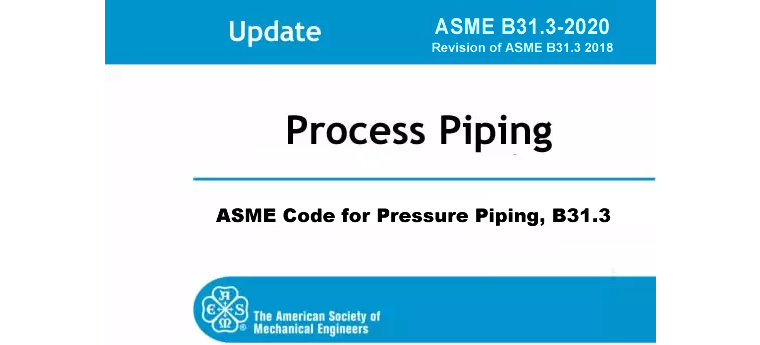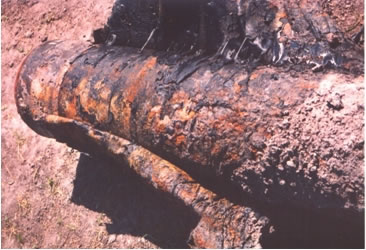What is Bellows Pressure Thrust?
Pressure thrust is present in all pressurized piping systems. It is simply the gage pressure times the inside area of the pipe. It acts at changes in direction, such as elbows, and at changes in pipe cross section, such as reducers. Pressure thrust is normally carried as an axial load by the pipe. However, inclusion of a bellows expansion joint, which is not intended to carry such axial loads, removes the normal means of resisting the pressure thrust. Therefore, other means, such as pipe anchors and hardware on the bellows such as tie rods, is required to carry the pressure thrust load.
The pressure thrust is the gage pressure times the area within the mean diameter (Dm) of a metallic bellows expansion joint. It can be helpful in system design to understand where the forces actually occur. Some pipe stress software use the simplifying assumption in the analysis that the force acts at the bellows, but only part of the force actually acts at that location.
Take for example an elbow, with a straight run of pipe to an expansion joint. A pressure thrust force acts at the elbow, which is P*pi*d2/4 where d is the inside diameter of the pipe. The pressure times the area between the inside diameter of the bellows and the inside diameter of the pipe acts at the end of the bellows. An additional area is on the sidewall of the bellows convolution. Half of the pressure thrust acting on the end sidewall is balanced with that acting on the adjacent side of the convolution, across the bellows crown. The other half of the pressure thrust pushes against the pipe, and is part of what is calculated as the bellows pressure thrust. So the total bellows pressure thrust is P*pi*Dm2/4, of which
P*pi*(Dm2 – d2)/4 is acting at the end of the bellows, pushing on the pipe if the bellows in under internal pressure.
If there is an anchor between an elbow and an unrestrained (meaning the expansion joint does not include hardware to carry the pressure thrust) bellows expansion joint that is intended to carry the pressure thrust, the load would be P*pi*Dm2/4. If there is an unrestrained bellows expansion joint in pipe connected to a vessel nozzle, there is a pressure thrust load
acting on the nozzle which is P*pi*(Dm2 – d2)/4 where d in this case is the inside diameter of the nozzle and a load acting on the vessel wall opposite the nozzle of P*pi*d2/4. The entire pressure thrust load of P*pi*Dm2/4 is acting on the vessel and must be resisted by the vessel foundation. Note the difference in pressure thrust force acting on the nozzle, which is P*pi*d2/4 for a pipe without an expansion joint and P*pi*(Dm2 – d2)/4 for a pipe with an unrestrained expansion joint, and the direction of the force is reversed.
[readon2 url=”index.php?option=com_rsform&view=rsform&formId=4&Itemid=620″]Click to Request Info[/readon2]






Hi Chuck,
Thanks very much for the article. I have a question. I’m having trouble visualizing what you mean by this statement: “The pressure times the area between the inside diameter of the bellows and the inside diameter of the pipe acts at the end of the bellows.” Would it be possible to make a sketch?
Also, what do you mean by ‘”…acts at he end of the bellows.” Where is this force present? On the inside face of the last convolution?
Thanks!
With a bellows fillet welded to the OD of a pipe, there will be pressure acting on the end of the pipe, within the bellows. The pressure is acting on the cross sectional area of the metal pipe wall. The creates a force that acts at essentially the end of the bellows.
Hello Chuck,
Greetings from the UK! I am currently working on a small calculation involving bellows and came across your excellent article on the subject through a google search – thanks.
I have a customer who has an existing vertical vessel, please see the (hopefully) attached sketch for a layout. This vessel has an upper dished end with a DN600 (24″) flanged manway (internal diameter D). Currently this manway is unused and is covered with a blank flange. The customer wants to know the implications of attaching bellows via a DN300 (12″) smaller pipe (internal diameter d) welded into the blank flange, to this connection as shown, he is mainly worried about any increased stresses on the dished end. The upper side of the bellows would be attached to rigid pipework/supports and the bellows would be unrestrained, ie no tie bars.
I’ve been through your article, which looks pretty similar to my application except for the difference in areas due to the manway cover, had a think about it and I reckon that the following would be the case:-
The force on the new DN300 nozzle due to the bellows = P*pi*(Dm2 – d2)/4
There is an opposing force due to the diameter change on the DN600 nozzle = P*pi*(D2 – d2)/4
Since D>Dm there would actually be a reduction in the force on the dished end compared to when the blank flange is present, so no problem.
The vertical load on the vessel mountings would be increased by P*pi*(Dm2)/4
The only change point would be with the DN600 flange loads – it will now have a concentrated annular load from above where the small nozzle joins it, opposed by a pressure from underneath. Would this flange therefore need to increase in thickness?
I would be most grateful if you could let me know if I’m in the right ball park with this, thanks.
Regards,
Andrew Wood
[img]H:JOB FILESJob Files 40001 – 4100040014 – BASF – Design Verification of Chorus Reactor Dished Heads (Design Only)1. Drawings & 3rd party design approvalSolidworks40014-0001.jpg[/img]
You are in the right ball park. But since you are cutting a hole in the flange, it needs to be assessed for that condition. For example, forgetting for the moment the bellows, putting a nozzle in a blind flange requires it to be checked, such as by nozzle area replacement assessment.
Hi Chuck,
Thanks for your reply. It’s very helpful.
Regards,
Andrew Wood